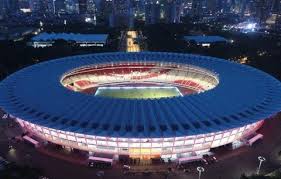- The ANZ Stadium
Opened: 1999
Capacity: 75,000
Notable Fixtures: 2000 Summer Olympic Games, 2015 AFC Asian Cup Final
Completed in March 1999 to host the 2000 Summer Olympics, so the ANZ Stadium is sometimes referred to as the Sydney Olympic Stadium. It is located in Sydney, Australia and has seen a lot of milestones in the Australian national football team’s history.
For example, Australia’s penalty shootout victory against Uruguay qualified the Australian national football team for the FIFA World Cup in 2006, their first since 1974. When Australia hosted the event in 2015, the national team also won their first AFC Asian Cup tournament over South Korea.
- Gelora Bung Karno
Opened: 1962
Capacity: 76,127
Notable Fixtures: 2007 Asian Cup Final, 2018 Asian Games

Located in Central Jakarta, Indonesia, the Gelora Bung Karno Main Stadium is named after the first president of the country. Origianlly, the stadium had a seating capacity of 110,000 but in 2006, the number of seats was reduced to 88,000 for the 2007 AFC Asian Cup and then further down to 76,000 for the Asian Games in 2008. In spite of these reductions, it is still the world’s 26th largest association football stadium and also Asia’s 8th largest.
- Bukit Jalil National Stadium
Opened: 1996
Capacity: 87,411
Notable Fixtures: 2007 Asian Cup, 2017 Southeast Asian Games
Located in Kuala Lumpur, the capital of Malaysia, the Bukit Jalil Stadium is the world’s ninth largest and the Southeast Asia’s largest football stadium.
Built for the 1998 Commonwealth Games, the Bukit Jalil National Stadium has hosted some major international multi-sporting events, including the 2007 AFC Asian Cup and the 2017 Southeast Asian Games. For its large size and passionate supporters clad in orange, the national stadium of Malaysia is truly a stadium fit to be a regional icon.